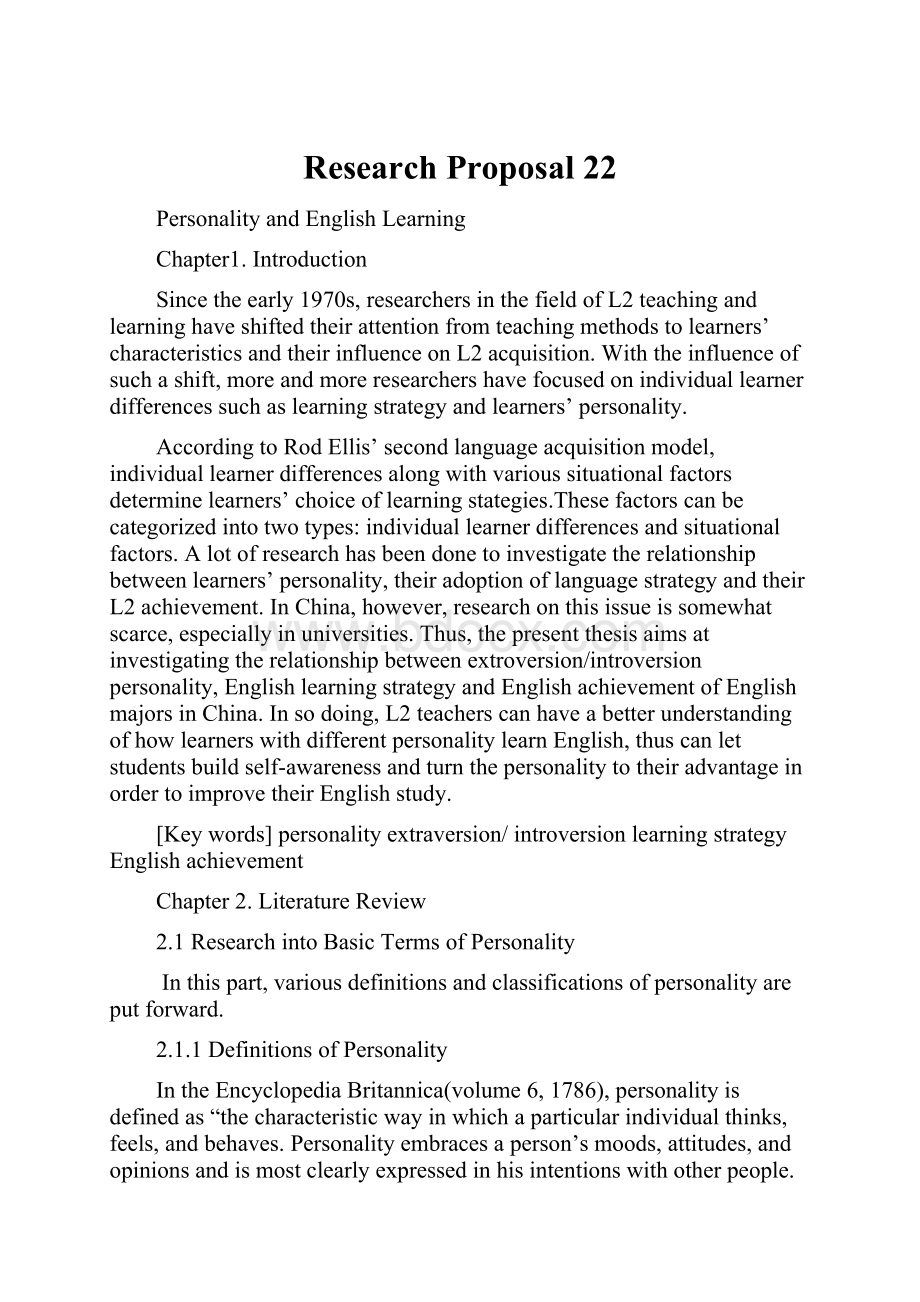Research Proposal 22.docx
《Research Proposal 22.docx》由会员分享,可在线阅读,更多相关《Research Proposal 22.docx(13页珍藏版)》请在冰豆网上搜索。

ResearchProposal22
PersonalityandEnglishLearning
Chapter1.Introduction
Sincetheearly1970s,researchersinthefieldofL2teachingandlearninghaveshiftedtheirattentionfromteachingmethodstolearners’characteristicsandtheirinfluenceonL2acquisition.Withtheinfluenceofsuchashift,moreandmoreresearchershavefocusedonindividuallearnerdifferencessuchaslearningstrategyandlearners’personality.
AccordingtoRodEllis’secondlanguageacquisitionmodel,individuallearnerdifferencesalongwithvarioussituationalfactorsdeterminelearners’choiceoflearningstategies.Thesefactorscanbecategorizedintotwotypes:
individuallearnerdifferencesandsituationalfactors.Alotofresearchhasbeendonetoinvestigatetherelationshipbetweenlearners’personality,theiradoptionoflanguagestrategyandtheirL2achievement.InChina,however,researchonthisissueissomewhatscarce,especiallyinuniversities.Thus,thepresentthesisaimsatinvestigatingtherelationshipbetweenextroversion/introversionpersonality,EnglishlearningstrategyandEnglishachievementofEnglishmajorsinChina.Insodoing,L2teacherscanhaveabetterunderstandingofhowlearnerswithdifferentpersonalitylearnEnglish,thuscanletstudentsbuildself-awarenessandturnthepersonalitytotheiradvantageinordertoimprovetheirEnglishstudy.
[Keywords]personalityextraversion/introversionlearningstrategyEnglishachievement
Chapter2.LiteratureReview
2.1ResearchintoBasicTermsofPersonality
Inthispart,variousdefinitionsandclassificationsofpersonalityareputforward.
2.1.1DefinitionsofPersonality
IntheEncyclopediaBritannica(volume6,1786),personalityisdefinedas“thecharacteristicwayinwhichaparticularindividualthinks,feels,andbehaves.Personalityembracesaperson’smoods,attitudes,andopinionsandismostclearlyexpressedinhisintentionswithotherpeople.Personalityisthosebehavioralcharacteristics,bothinherentandacquired,whichdistinguisheachindividualandareobservableinhisrelationstotheenvironmentandtothesocialgroup.”
Manypersonalitypsychologistshavegivendifferentdefinitionsofpersonality:
Eysenk:
Personalityismoreorlessstableandenduringorganizationofapersona’scharacter,temperament,intellectandphysique,whichdetermineshisuniqueadjustmenttohisenvironment(p.496).
Cattell:
Personalityisthatwhichpermitsapredictionofwhatapersonwilldoinagivensituation…Personalityis…concernedwithallthebehavioroftheindividual,bothovertandundertheskin(p.496).
2.1.2Extraversion/Introversion
EysenckandChan(1982:
154)describeextraversionandintroversionasthefollowing:
Extraversionischaracterizedbybeingoutgoing,talkative,andactive.Extravertsaresocial,likeparties,havemanyfriendsandneedexcitement;theyarepassion-seekersandrisktakers,likepracticaljokesandarelivelyandactive.Onthecontrary,introvertsarechronicallyover-arousedandnervousandarethereforeinneedofpeaceandquiettobringthemuptooptimallevelofperformance.Theyarequiet,preferreadingtomeetingpeople,havefewbutclosefriendsandusuallyavoidexcitement.
Liebert(1974:
148)regardedtheintroversion-extraversioncontinuumastworatheroppositestylesindealingwithone’ssocialenvironment.Atoneextreme,anintrovertwouldbeshyandanxiousinallnewsocialsituationsandwouldmuchprefertowithdrawfrompeoplethantoapproachthem.Theextravert,incontrast,wouldbedistinguishedbyanunusualeaseamongpeopleandamarkedabilityandwillingnesstointroducehimselfandmakefriendswithpeople.
2.2.ResearchonExtraversion/IntroversionandL2Acquisition
ResearchesintheL2acquisitionfieldpayinggreatattentiontoextroversion/introversionpersonality,canbedividedintotwogroups.Thefirstgrouphavemaderesearchesontherelationshipbetweenextroversion/introversionandlanguagelearningachievements,whiletheothergroupontherelationshipbetweenextroversion/introversionandlanguagelearningstrategies.
Thefirstgroupofresearchersfindthatextrovertswouldperformbetterthantheirintrovertcounterpartsinbothoverallskillsandinsomespecificlanguageskills,especiallyinspeakingandlisteningskillsandthatextrovertedlearnersdobetterinacquiringbasicinterpersonalcommunicationskills.Strong(1983)foundthatextrovertchildrenlearntfaster.Robson(1992)foundthatlearnerswhowereextrovertandemotionallystableweremorelikelytoengageinoralactivitiesthantheintrovert.
StillsomescholarsdrawtheconclusionthattheintroverthaveanadvantageinEnglishperformanceasawholeandinsomespecificskillssuchaswriting,reading,grammarandthatintrovertedlearnerswilldobetteratdevelopingcognitiveacademiclanguageability.Busch(1982)foundanegativerelationshipwithL2proficiency.Wang(1990)foundthatpersonalityhaslittleinfluenceonone’scomprehensiveskills.Hu(2002)foundthatextravertdispositionbroughtpositiveeffectonlearningforeignlanguage.
However,theotherresearchersfindthatthereisnoobviousrelationshipbetweentheextroversion/introversionpersonalityandthelearners’Englishperformance.Lu(2002)foundthatthelearnerswhoweremidwaybetweenextroversionandintroversionperformedbest,andtheintrovertedlearnerstookthesecondplacewhiletheextrovertedonesweretheleastproficient.
InChina,onlyinrecentyears,someresearchersbegintoinvestigatetherelationbetweenextroversion/introversionpersonalityandtheemploymentoflanguagelearningstrategies.Wang(2005)investigatedthatthereexitedarelationshipbetweenpersonalitytypesandwritingstrategies,andpersonalitytypesplayedanimportantroleinwritingandthroughstrategiespersonalitytypesexertedinfluenceonwritingperformance.Zhang(2006)foundthatextrovertlearnerswereinclinedtouselearningstrategiesgenerallymorefrequentlythanintrovertlearnersandparticularlyintheuseofmemory,cognitiveandcompensationstrategies.TheresearchresultissimilarwiththatofTang(2005),whoexposedthatextrovertsgenerallyemployedstrategiesmorefrequentlythatintroverts.
2.3LanguageLearningStrategies
Oxford(1990:
8)defineslanguagelearningstrategiesas“specificactionstakenbythelearnertomakelearningeasier,faster,moreenjoyable,moreself-directed,moreeffective,andmoretransferabletonewsituations.”
Chamot(1987:
71)putsforwardthat“learningstrategiesaretechniques,approaches,ordeliberateactionsthatstudentstakeinordertofacilitatethelearningandrecallofbothlinguisticandcontentareainformation.”
Cohen(2000:
4)believes“languagelearningandlanguageusestrategiescanbedefinedasthoseprocesseswhichareconsciouslyselectedbylearnersandwhichmayresultinactiontakentoenhancethelearningoruseofasecondlanguageorforeignlanguage,throughthestorage,retention,recall,andapplicationofinformationaboutthatlanguage”.
WenQiufang(1993)defineslearningstrategiesasactionstakenbylearnerforefficientlearning.Thedefinitionemphasizestwopoints:
(1)thepurposeofusingstrategiesistoimprovelearningefficiency;
(2)thenatureofstrategiesislearners’actionsratherthanideasandtheactionscanbebothexternalandinternal.
However,Ellis(1994)believesthatthebestapproachtodefininglearningstrategiesistolisttheirmaincharacteristics.Ellismakesalistofeightcharacteristics:
(1)Strategiesrefertobothgeneralapproachesandspecificactionsortechniquesusedtolearnasecondlanguage;
(2)Strategiesareproblem-orientated—thelearnerdeploysastrategytoovercomesomeparticularlearningproblem;(3)Learnersaregenerallyawareofthestrategiestheyuseandcanidentifywhattheyconsistofiftheyareaskedtopayattentiontowhattheyaredoing/thinking;(4)Strategiesinvolvelinguisticbehaviorandnon-linguisticbehavior;(5)Linguisticstrategiescanbeperformedinthesecondlanguageaswellasinthefirstlanguage;(6)Somestrategiesarebehavioralwhileothersaremental,thussomestrategiesaredirectlyobservable,whileothersarenot;(7)Inthemain,strategiescontributeindirectlytolearningbyprovidinglearnerswithdataaboutthesecondlanguagewhichtheycanthenprocess.However,somestrategiesmaycontributedirectly;(8)Strategies’employmentvariesconsiderablyasaresultofboththekindoftaskthelearnerisengagedinandindividuallearnerpreferences.
Allinall,learningstrategiesareactionstakenbylearnerstoaidtheacquisition,storage,andretrievalofinformation.Nomatterwhattheyarecalled,thereisnodoubtstrategiescanmakelearningefficientandeffective.
2.3.1ClassificationoflearningStrategies
Justasdifferentresearchersdefinelearningstrategydifferently,languagelearningstrategieshavebeenclassifiedbymanyscholarsindifferentways.
Amongdifferentclassificationsoflanguagelearningstrategies,Oxford’taxonomyis“perhapsthemostcomprehensiveclassificationoflearningstrategiestodate”(Ellis,1999:
530).
Oxford(1990)dividedlanguagelearningstrategiesintotwogeneraltypes,directstrategiesandindirectstrategiesandtheycanbefurthersubdividedinto6groups.Directstrategiesrefertomemorystrategies,cognitivestategies,compensationstrategies,whileindirectstrategiesconsistofmetacognitivestrategies,affectivestrategiesandsocialstrategies.Amongthem,memorystrategiesaretechniquesadoptedtohelplearnerstoreandretrievenewinformationefficiently,includingcreatingmentallinkages,applyingimagesandsounds;andemployingactions.Cognitivestrategiesareskillsenablinglearnerstounderstandand